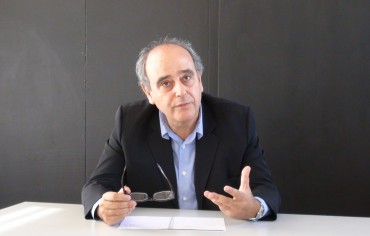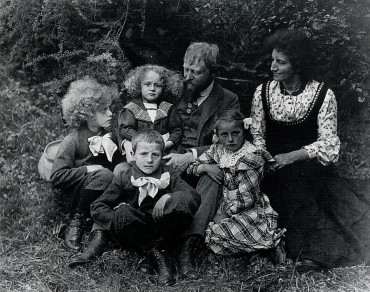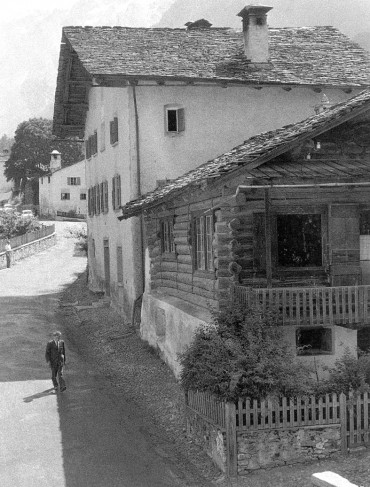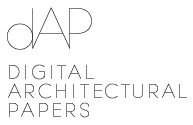Selected Topic
Issue 3 - On Giacometti – Physical and Cultural Landscapes in the Bergell (June 2011)
Show articles
Prof. Dr. Josep Lluís Mateo

Giacometti famiiy, 1911. Das Bergell. Heimat der Giacometti. Verlag Scheidegger, Zurich, 1994.

Giacometti house and atelier in Stampa. Alberto Giacometti. Traces d’une amitié. Photos by E. Scheidegger. Maeght Editeur, 1991
4.7.2012 – Issue 3 - On Giacometti – Mateo Josep Lluís – Studio, Videos
narrative and physical facts
by Josep Lluís Mateo
Our Giacometti project deals with a very important question that is the meaning of the word context. What is a context? Which is the context?
Of course the context is connected with the physical facts, with the geography, the topography, with the climate, the snow, the temperature and also with the history. Besides the physical facts, we wanted also to talk about the cultural context that is connected with immaterial facts, immaterial things. In that sense, this kind of ghost presence of what we might call the spirits of the place, the Genius Loci in Latin terms, was impressive. We were interested in Giacometti's history, the family history - the father and the uncle both very important painters, the son one of the best artists - coming from a very remote area with almost no light in winter during nearly eight months. The whole adventure of the Giacometti's history was what we could name cultural context.
There were also some traces, some specific physical traces like houses and tombs - Adolf Loos has established this parallelism between the tomb and the architecture - and the atelier, the place where they were working. Our students were confronted with this kind of extraordinary landscape, remote landscape, with this kind of history and with some specific physical remains.
The idea was to deal with the context in a broader sense, not purely picturesque, not in a purely physical and direct sense. And also was to try to confront our students with a very strong experience that allowed them to develop new strategies, new forms and try to avoid the conventional and the vulgarity that is one of the most unpleasant experiences while teaching and probably while studying, to repeat something that you vaguely know. In a way this non-knowledge condition could be an interesting starting point to produce something new. This was the scenery we wanted to provoke to them.
In fact, coming back to the original idea of the semester, the projects are connected to what could be called as a chapel experience. The chapel is a place, was a place, probably is no longer in use, where some kind of spirits are present, a physical place with some kind of connection to immaterial forces. Create this kind of space has been also the goal of this exercise.
Regarding the students' work, there were in my opinion many interesting projects. I would like to point out that, as teachers, we just ask the questions but we don't design the answers. The best teacher to me has been always the one who was able to ask the question that generates the good answers. The quality of the question is in relationship with the quality of the answers.
Among the big quantity of special and quality answers, I can remember several. First, the project of Dario Wohler tries to react in a very archaic way to this kind of history, to this kind of cultural facts, reacting in terms of architecture in a pre-historical way, in a very archaic way. Second, the project of Rebecca Bornhauser is more in relationship with the natural forces, like the strong presence of the snow during nearly eight months a year, and as in architecture the snow is connected to the roof, working with the roof as a protagonist. And finally, the project of Xiong Sun deals with the landscape big forces, thinking the building as a kind of gate into this infinite landscape. These were some of the projects that I still remember.
–
Image credits (video)
- Winter landscape (Stampa), 1897. Giovanni Giacometti 1868-1933. Leben und Werk.. D. Schwarz. Schweizerisches Institut für Kunstwissenschaft, Zürich, 1996.
- Giacometti in the Paris atelier. Alberto Giacometti. Traces d’une amitié. Photos by Ernst Scheidegger. Maeght Editeur, 1991.
- My birthplace, 1914. Augusto Giacometti. Wege zum Abstraktion.Bündner Kunstmuseum Chur. Scheidegger & Spiess, 2003.
- Giacometti house and atelier in Stampa. Alberto Giacometti. Traces d’une amitié. Photos by Ernst Scheidegger. Maeght Editeur, 1991.
- Borgonovo cemetery. Scheiegger-Spliess Verlag 1997, E. Scheidegger.
- Project by Dario Wohler. Chair Prof. Mateo ETH Zurich.
- Project by Rebecca Bornhauser. Chair Prof. Mateo ETH Zurich.
- Project by Xiong Sun. Chair Prof. Mateo ETH Zurich.
Download article as PDF

